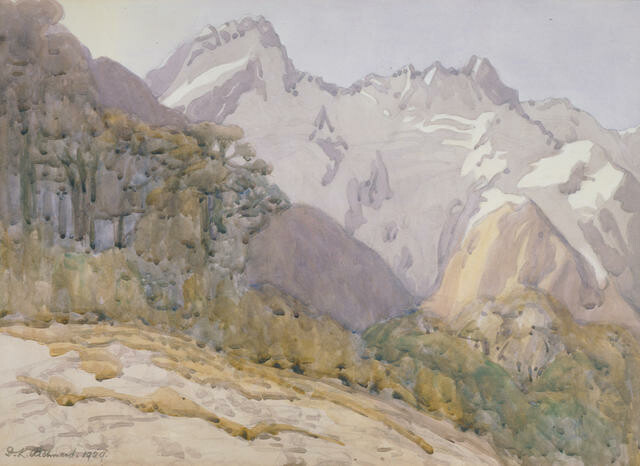Dorothy Kate Richmond
Aotearoa New Zealand, b.1861, d.1935
Mount Sefton from The Hermitage
- 1929
- Watercolour
- Presented by the Canterbury Society of Arts, 1932
- 500 x 700mm
- 69/23
- View on google maps
Location: Sir Robertson and Lady Stewart Gallery
Tags: glaciers (bodies of water), hills, landscapes (representations), mountains, natural landscapes, plein-air
Snow-clad, steeply pitched Kakīroa on the craggy Aroarokāehe range is among the highest peaks in the Aoraki Mount Cook district. Conforming to prevailing colonial practice, in 1862 they were renamed Mount Sefton and the Moorhouse Range respectively by geologist and museum director Julius von Haast. William Sefton Moorhouse was then the superintendent of the Canterbury Province. What was then difficult-to-reach terrain became more accessible from 1885, when the Hermitage hotel opened for tourists. The hotel’s location in what is now Mount Cook Village is very near the vantage points later taken by watercolour painters Margaret Stoddart, Dorothy Richmond and Esther Hope.
He Kapuka Oneone – A Handful of Soil (from August 2024)
Exhibition History
This watercolour was painted from the grounds of the Hermitage during a painting expedition Dorothy Kate Richmond made to the Mckenzie Country and Mt Cook in 1929.
It shows Richmond’s mature style in which she has used fluid washes of colour. Her broad, loose handling of the medium and the simplified range of colours show the influence of Stanhope (1857–1947) and Elizabeth Forbes (1859–1912), with whom Richmond studied in 1898 at the Newlyn School of Art, in Cornwall, England.
Born in Auckland, Dorothy was the daughter of the watercolour artist James Crowe Richmond. In 1878 she was awarded a scholarship to the Slade School of Art in London. She returned to teach at Nelson College for Girls but, on the death of her father in 1898, went back to England. In 1903 Richmond opened a studio in Wellington and became a central figure in the city’s art circles.

